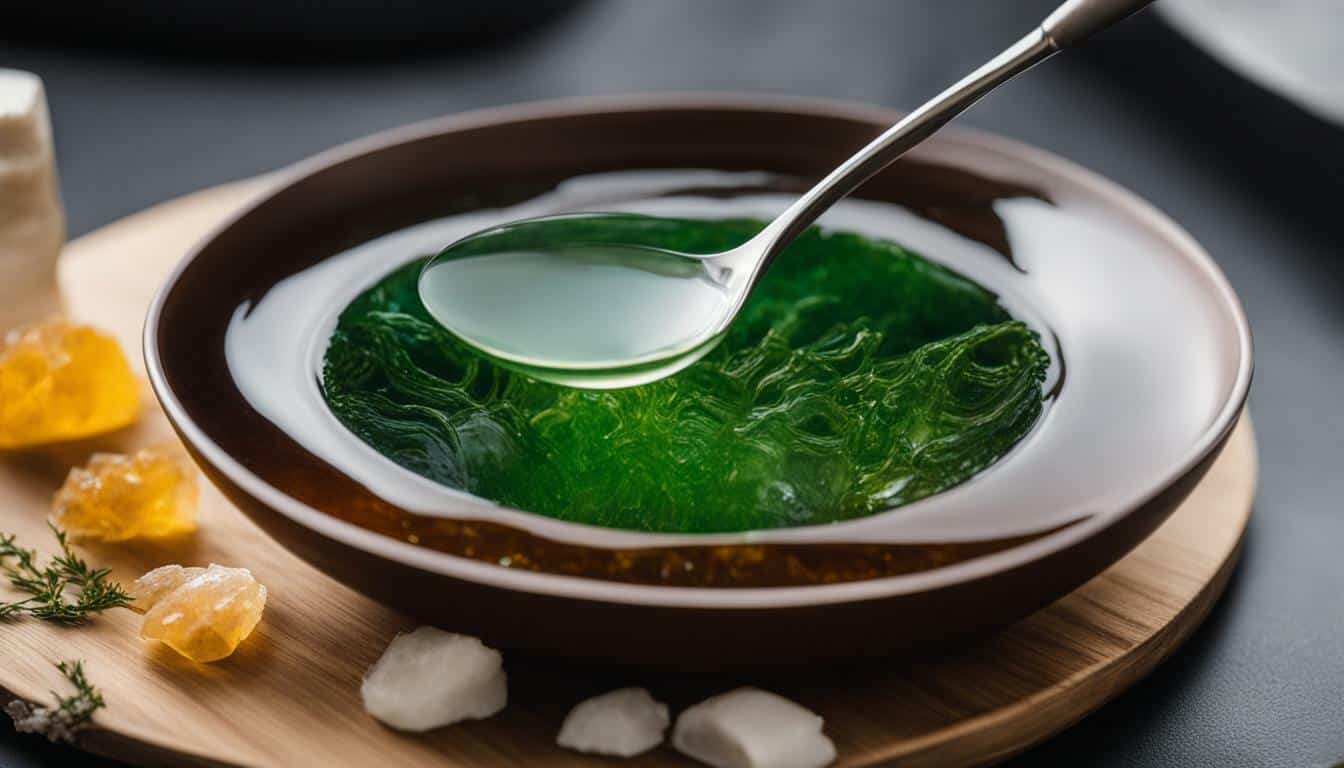
Gelatin is known for its jiggly consistency and use in desserts, but did you know it’s also a rich source of collagen? Collagen is a protein that provides structure to our skin, nails, and joints, and consuming gelatin can help boost collagen production in our bodies.
In this section, we’ll explore how much collagen is in gelatin and its benefits for our overall health and wellness. Let’s dive deep into the world of gelatin and collagen to uncover its secrets.
Key Takeaways:
- Gelatin is a natural source of collagen and can help boost collagen production in our bodies.
- Collagen plays an essential role in maintaining the structure of our skin, nails, and joints.
- Incorporating collagen-rich foods and supplements into our diet can optimize our collagen levels for improved overall health and well-being.
Understanding Collagen and Its Importance
Collagen is a protein that plays a crucial role in our bodies. It is a major component of connective tissues such as bones, cartilage, and skin. Collagen production is essential for maintaining healthy connective tissue and promoting overall wellness.
Collagen is produced naturally by our bodies but can decline as we age. คอลลาเจนผิวขาวแบบชง This decline can lead to signs of aging such as wrinkles and joint pain. However, collagen peptides, which are smaller versions of collagen, can enhance the body’s natural collagen production.
Collagen is also vital for connective tissue. It provides structure and strength while also promoting flexibility. Connective tissue is found throughout our bodies, including our muscles, tendons, and ligaments.
Ensuring adequate collagen production is essential for maintaining optimal health and well-being.
Gelatin: A Natural Source of Collagen
Gelatin is a collagen-rich food that can boost collagen production in our bodies. It is derived from collagen-rich animal bones, skin, and connective tissues. Gelatin can be consumed as a supplement or obtained from bone broth, which is made by boiling animal bones and connective tissues.
The benefits of gelatin are numerous, as it offers a range of nutrients that support collagen synthesis and promote healthy skin, nails, and joints. Gelatin contains amino acids such as glycine, proline, and hydroxyproline, which are essential for collagen production. These amino acids are not commonly found in other protein sources, which makes gelatin a unique and valuable addition to our diets.
In addition to supporting collagen synthesis, gelatin has other health benefits as well. It can improve gut health, boost the immune system, and promote better sleep. Gelatin also contains anti-inflammatory properties that can reduce joint pain and stiffness.
| Gelatin Benefits: | |
|---|---|
| Boosts collagen production | Improves gut health |
| Promotes healthy skin, nails, and joints | Boosts the immune system |
| Reduces joint pain and stiffness | Promotes better sleep |
Overall, gelatin is a natural and effective way to increase collagen levels in our bodies and improve our overall health. Incorporating gelatin into our diets can provide numerous benefits and promote healthy aging.
Next, we will dive deeper into the methods used to determine the collagen content in gelatin and the different types of gelatin available.
Determining the Collagen Content in Gelatin
Measuring the collagen content in gelatin is a complex process that requires various analysis techniques. Gelatin samples are first hydrolyzed to break down proteins into peptides, and then the resulting collagen peptides are isolated and quantified.
One common method for collagen measurement is the hydroxyproline assay, which involves the detection of hydroxyproline residues in collagen peptides. Another method is the biuret method, which involves the detection of peptide bonds in collagen.
Collagen content can also vary depending on the type of gelatin. Type I gelatin is derived from collagen of bovine hides and has a higher collagen concentration compared to type II gelatin, derived from collagen in chicken cartilage.
| Measurement Method | Pros | Cons |
|---|---|---|
| Hydroxyproline assay | Highly specific to collagen peptides | Requires hydrolysis step that can be time-consuming |
| Biuret method | Can detect other proteins besides collagen | Less specific compared to hydroxyproline assay |
With the varying types of gelatin and methods for determining collagen content, it’s important to consider the source of gelatin and the measurement method used when incorporating gelatin into your diet for collagen benefits.
Collagen-Rich Foods Beyond Gelatin
Gelatin is not the only food source that can boost collagen levels in the body. There are a variety of other collagen-rich foods that you can incorporate into your diet for overall health and wellness.
Food sources of collagen include:
- Bone broth: Made from simmering animal bones, bone broth is a rich source of collagen.
- Wild-caught fish: Fish like salmon and tuna are high in collagen and also contain omega-3 fatty acids for added health benefits.
- Egg whites: Egg whites are a good source of glycine and proline, two amino acids that are essential for collagen production.
- Citrus fruits: Citrus fruits like oranges and lemons are high in vitamin C, which is necessary for collagen synthesis.
- Leafy greens: Vegetables like spinach, kale, and collard greens are loaded with antioxidants that protect and enhance collagen production.
While incorporating collagen-rich foods into your diet is important, it may not always be possible to consume enough to meet your body’s needs. In this case, collagen supplementation may be a viable option.
Collagen supplements come in various forms, including:
- Capsules or pills
- Powders
- Liquids or shots
Collagen supplements can provide several benefits, including improved skin elasticity, joint mobility, and bone strength.
However, it’s important to note that not all collagen supplements are created equal, and the quality and purity of the supplement can impact its effectiveness. Be sure to do your research and choose a reputable brand.
Overall, a healthy diet rich in collagen-promoting foods coupled with collagen supplementation can help boost your body’s collagen levels for improved health and wellness.
Tips for Maximizing Collagen Absorption
While incorporating collagen-rich foods and supplements into your diet can help boost collagen levels in your body, maximizing collagen absorption is equally crucial to harness its benefits. Here are some tips for enhancing collagen absorption:
- Consume Vitamin C: Vitamin C plays a vital role in collagen synthesis, and consuming foods rich in Vitamin C, such as citrus fruits, broccoli, and peppers, can enhance collagen absorption.
- Reduce Sugar Intake: High sugar intake can cause the breakdown of collagen, so reducing sugar consumption can help preserve collagen levels in the body.
- Include Antioxidants: Antioxidants can neutralize free radicals that damage collagen and enhance collagen absorption. Foods rich in antioxidants include berries, leafy greens, and nuts.
- Stay Hydrated: Adequate hydration keeps the skin moisturized and plump, promoting collagen synthesis and absorption. Aim for at least eight glasses of water a day.
- Engage in Regular Exercise: Exercise can promote collagen synthesis and absorption. Incorporate weight-bearing exercises, such as strength training and resistance exercises, into your workout regimen.
- Consider Collagen Supplements: Collagen supplements, such as collagen peptides, can enhance collagen absorption and promote overall health. Consult with a healthcare professional before taking any supplements.
By incorporating these dietary factors and lifestyle habits, you can maximize collagen absorption and make the most out of collagen-rich foods and supplements, leading to improved skin, nail, and joint health.
Conclusion
In conclusion, gelatin is a fantastic natural source of collagen, providing numerous benefits for our skin, nails, and joints. By understanding the importance of collagen, determining the collagen content in gelatin, and embracing collagen-rich foods beyond gelatin, we can take significant steps toward improved overall health and wellness.
Maximizing Collagen Absorption
However, to fully optimize the benefits of collagen, it’s essential to focus on maximizing collagen absorption. This can be achieved through various dietary factors and lifestyle habits, such as regular exercise, reducing stress, and getting enough sleep. Additionally, collagen supplements can serve as a convenient and effective way to boost collagen levels in our bodies.
By following these tips and incorporating collagen-rich foods into our diets, we can ensure we are getting the most out of this essential protein. So, dive deep into the world of gelatin and collagen and unlock the secrets to a healthier you!
FAQ
How much collagen is in gelatin?
Gelatin is a rich source of collagen. However, the exact collagen content can vary depending on the type and brand of gelatin. It is best to refer to the product’s packaging or consult the manufacturer for specific collagen measurements.
What are the benefits of collagen for skin, nails, and joints?
Collagen provides numerous benefits for skin, nails, and joints. It helps improve skin elasticity, reduces the appearance of wrinkles, strengthens nails, and supports joint health by promoting cartilage formation and reducing joint pain.
What is collagen and why is it important?
Collagen is a protein that forms the structural foundation of our skin, bones, tendons, and other connective tissues. It plays a crucial role in maintaining tissue structure, promoting wound healing, and supporting overall body function.
How does gelatin contribute to collagen production?
Gelatin contains amino acids that are vital for collagen production in our bodies. Consuming gelatin can help supply the necessary building blocks for collagen synthesis, supporting healthier skin, nails, and joints.
How is the collagen content in gelatin determined?
The collagen content in gelatin is determined using various measurement methods and analysis techniques. These may include hydroxyproline quantification, biochemical assays, and molecular weight determination. Different types of gelatin have varying collagen concentrations.
Are there other collagen-rich foods besides gelatin?
Yes, there are various collagen-rich foods that can help boost collagen levels in our bodies. Some examples include bone broth, fish collagen supplements, chicken skin, and certain seafood like salmon and tuna.
How can collagen absorption be maximized?
To enhance collagen absorption, it is recommended to consume collagen-rich foods alongside vitamin C-rich sources, as vitamin C aids in collagen synthesis. Additionally, maintaining a balanced diet, staying hydrated, and avoiding excessive alcohol and smoking can also support collagen absorption.
